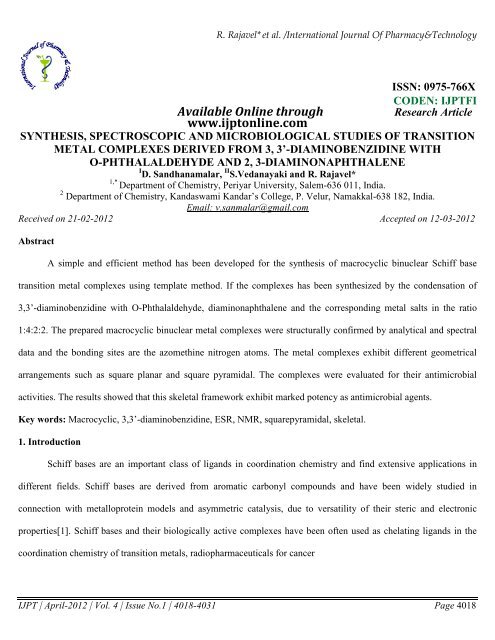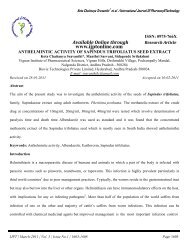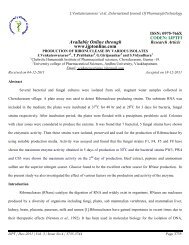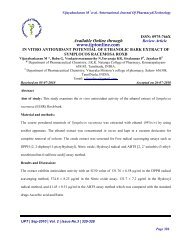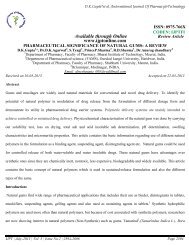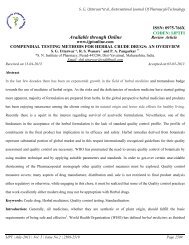Available Online through www.ijptonline.com
Available Online through www.ijptonline.com
Available Online through www.ijptonline.com
Create successful ePaper yourself
Turn your PDF publications into a flip-book with our unique Google optimized e-Paper software.
R. Rajavel* et al. /International Journal Of Pharmacy&Technology<br />
ISSN: 0975-766X<br />
CODEN: IJPTFI<br />
<strong>Available</strong> <strong>Online</strong> <strong>through</strong><br />
Research Article<br />
<strong>www</strong>.<strong>ijptonline</strong>.<strong>com</strong><br />
SYNTHESIS, SPECTROSCOPIC AND MICROBIOLOGICAL STUDIES OF TRANSITION<br />
METAL COMPLEXES DERIVED FROM 3, 3’-DIAMINOBENZIDINE WITH<br />
O-PHTHALALDEHYDE AND 2, 3-DIAMINONAPHTHALENE<br />
I D. Sandhanamalar, II S.Vedanayaki and R. Rajavel*<br />
1,*<br />
Department of Chemistry, Periyar University, Salem-636 011, India.<br />
2 Department of Chemistry, Kandaswami Kandar’s College, P. Velur, Namakkal-638 182, India.<br />
Email: v.sanmalar@gmail.<strong>com</strong><br />
Received on 21-02-2012 Accepted on 12-03-2012<br />
Abstract<br />
A simple and efficient method has been developed for the synthesis of macrocyclic binuclear Schiff base<br />
transition metal <strong>com</strong>plexes using template method. If the <strong>com</strong>plexes has been synthesized by the condensation of<br />
3,3’-diaminobenzidine with O-Phthalaldehyde, diaminonaphthalene and the corresponding metal salts in the ratio<br />
1:4:2:2. The prepared macrocyclic binuclear metal <strong>com</strong>plexes were structurally confirmed by analytical and spectral<br />
data and the bonding sites are the azomethine nitrogen atoms. The metal <strong>com</strong>plexes exhibit different geometrical<br />
arrangements such as square planar and square pyramidal. The <strong>com</strong>plexes were evaluated for their antimicrobial<br />
activities. The results showed that this skeletal framework exhibit marked potency as antimicrobial agents.<br />
Key words: Macrocyclic, 3,3’-diaminobenzidine, ESR, NMR, squarepyramidal, skeletal.<br />
1. Introduction<br />
Schiff bases are an important class of ligands in coordination chemistry and find extensive applications in<br />
different fields. Schiff bases are derived from aromatic carbonyl <strong>com</strong>pounds and have been widely studied in<br />
connection with metalloprotein models and asymmetric catalysis, due to versatility of their steric and electronic<br />
properties[1]. Schiff bases and their biologically active <strong>com</strong>plexes have been often used as chelating ligands in the<br />
coordination chemistry of transition metals, radiopharmaceuticals for cancer<br />
IJPT | April-2012 | Vol. 4 | Issue No.1 | 4018-4031 Page 4018
R. Rajavel* et al. /International Journal Of Pharmacy&Technology<br />
targeting[2], agrochemicals[3], model systems for biological macromolecules[4], catalysts[5] and as dioxygen<br />
carriers[6].<br />
The great interest in synthetic macrocycles and their corresponding metal <strong>com</strong>plexes is related to the fact that they<br />
can mimic naturally-occurring macrocyclic molecules in their structural features. The formation of macrocyclic<br />
<strong>com</strong>plexes depends significantly on the dimension of the internal cavity, on the rigidity of the macrocycle, on the<br />
nature of its donor atoms and on the <strong>com</strong>plexing properties of the counter ion. The syntheses of the macrocyclic<br />
ligands are generally carried out in the presence of a suitable salt, the cation of which is assumed to act as template<br />
for the ring formation[7,8].<br />
The stability of macrocyclic metal <strong>com</strong>plex depends upon a number of factors, including the number and type of<br />
donor atoms present in structure and their relative positions within the macrocyclic skeleton, as well as the number<br />
and size of the chelate rings formed on <strong>com</strong>plexation.<br />
In the present study the <strong>com</strong>plexes was prepared by the template condensation of 3,3’- Diaminobenzidine<br />
with O-phthaladehyde and diaminonaphthalene and the transition metals like Cu(II), Ni(II) acetate and perchlorate<br />
salts and VO(II) to afford the corresponding binuclear macrocyclic Schiff base <strong>com</strong>plexes. These <strong>com</strong>plexes were<br />
characterized with the help of various physicochemical techniques like IR, magnetic susceptibilities. Elemental<br />
analysis and conductance measurements. Recently, a wide varieties of the Cu(II), Ni(II) and VO(II) <strong>com</strong>plexes of<br />
Schiff base derivatives including <strong>com</strong>partmental and macrocyclic <strong>com</strong>plexes was tested invitro for their antibacterial<br />
and antifungal activities against human pathogenic bacteria [using disc diffusion method(DD)][9-11]. The structure<br />
has been dibasic with four nitrogen atoms and can coordinate with two metal ions to form binuclear Cu(II), Ni(II) and<br />
VO(II) <strong>com</strong>plexes.<br />
The binuclear macrocyclic Schiff base metal <strong>com</strong>plexes are investigated for antibacterial and antifungal<br />
properties. Gram-positive bacteria(staphylococcus auerus), Gram-negative bacteria (pseudomonas fluorescens) and<br />
two fungi (Aspergillus fumigatus) were used in this study to assess their antimicrobial properties. The copper and<br />
IJPT | April-2012 | Vol. 4 | Issue No.1 | 4018-4031 Page 4019
R. Rajavel* et al. /International Journal Of Pharmacy&Technology<br />
vanadium <strong>com</strong>plexes have more effective whereas the nickel <strong>com</strong>plex exhibit mild antibacterial and antifungal<br />
activities against these organisms.<br />
2. Materials and methods<br />
All the chemicals used were purchased from Aldrich. Solvents used were of analytical grade and purchased<br />
<strong>com</strong>mercially and used such as. The purity of metal <strong>com</strong>plexes were tested by TLC.<br />
2.1. Methods<br />
Elemental analysis(C, H N) was obtained using Perkin Elmer elemental analyzer. The infrared spectra were<br />
recorded in Perkin-Elmer-283 spectrophotometer in the range of 4000-200 cm −1 and electronic spectra in DMF were<br />
obtained using Shimadzu UV-265 spectrometer. Conductivity measurements were carried out at room temperature on<br />
freshly prepared 10 −3 M DMF solutions using a coronation digital conductivity meter. The magnetic studies were<br />
carried out at room temperature on a Gouy balance calibrated with Hg[Co(SCN) 4 ]. The cyclic voltammetry studies<br />
were carried out in digital CHI 760C. The electrochemical behavior of the <strong>com</strong>plexes was examined by employing a<br />
platinum electrode as working electrode, Ag/AgCl as a reference electrode and platinum wire as auxiliary electrode.<br />
The working media consisted of DMF containing 0.1M tetra butyl ammonium perchloride(TBAP) as supporting<br />
electrolyte. The EPR spectra of Cu(II) <strong>com</strong>plex were recorded on Bruker EMX Plus at room temperature. The<br />
antibacterial activity of the <strong>com</strong>pounds were determined by using the disc diffusion method.<br />
2.2. Antimicrobial activity<br />
The standardized disk-diffusion method[12, 13] was followed to determine the activity of the synthesized<br />
<strong>com</strong>pounds against the sensitive organisms Gram-positive(staphylococcus auerus) and Gram-negative bacteria<br />
(pseudomonas fluorescens) and fungi ( Aspergillus fumigatus) Streptomycin was used as a standard reference in the case<br />
of bacteria while Fluconazole was used as a standard antifungal refrence.<br />
The tested <strong>com</strong>pounds were dissolved in[DMSO which has no inhibition activity] to get concentration of 2<br />
mg/mL. The test was performed on medium potato dextrose agar(PDA) which contains infusion of 200 g potatoes, 6<br />
g dextrose and 15 g agar[14]. Uniform size filter paper disks(three disks per <strong>com</strong>pound) were impregnated by equal<br />
IJPT | April-2012 | Vol. 4 | Issue No.1 | 4018-4031 Page 4020
R. Rajavel* et al. /International Journal Of Pharmacy&Technology<br />
volume (10µL) from the specific concentration of dissolved test <strong>com</strong>pounds and carefully placed on incubated agar<br />
surface. After incubation for 36 h at 27°C in the case of bacteria and for 48 h at 24°C in the case of fungi.<br />
2.3. Synthesis of the <strong>com</strong>plexes<br />
The <strong>com</strong>plexes were synthesized using template method by condensing 3,3’-diaminobenzidine with O-<br />
phthalaldehyde and diaminonaphthalene in the presence of respective metal salt. To a hot stirring methanolic solution<br />
of (20ml) of 3,3’-diaminobenzidine was added to the metals like Cu, Ni and VO salt(0.2mmol) dissolved in the<br />
minimum quantity of methanol (∼20ml). The resulting solution was boiled under reflux for ½ hr. Then the methanolic<br />
solution of O-phthalaldehyde(0. 4mmol) was added after that added a methanol solution of<br />
diaminonaphthalene(0.2mmol) in the same mixture and refluxing was continued for 8hrs. The mixture was<br />
concentrated to half of its volume and kept in a desiccator overnight. The <strong>com</strong>plexes obtained as solid were then<br />
filtered, washed with methanol and diethylether, dried in vacuum. The <strong>com</strong>plexes are soluble in DMF and DMSO,<br />
but are insoluble in <strong>com</strong>mon organic solvents and water. The <strong>com</strong>plexes were found thermally stable up to ∼240-<br />
260°C and then de<strong>com</strong>posed. The proposed structure of the <strong>com</strong>plexes has been shown in Fig.I.<br />
Fig-1: Proposed structure of the <strong>com</strong>plex.<br />
N<br />
N<br />
X'<br />
M<br />
N<br />
N<br />
N<br />
N<br />
X'<br />
M<br />
N<br />
N<br />
X<br />
Where, M= Cu(II), Ni(II) and VO(II)<br />
X’= CH 3 COO - ; X= 2ClO 4 ; 2SO 4<br />
IJPT | April-2012 | Vol. 4 | Issue No.1 | 4018-4031 Page 4021
3. Results and Discussion<br />
R. Rajavel* et al. /International Journal Of Pharmacy&Technology<br />
All the <strong>com</strong>plexes were have the corresponding colored solids and are soluble in DMF and stable at room<br />
temperature. The macrocyclic binuclear Schiff base <strong>com</strong>plexes were characterized by elemental analysis, molar<br />
conductivity, IR, UV, EPR, electrochemical and thermal studies are gives satisfactory results. The in vitro<br />
antibacterial screening effects of the investigated <strong>com</strong>pounds were tested against the gram (+ve) and gram (-ve)<br />
bacteria and antifungal activities using disc diffusion method.<br />
3.1. Molar conductance measurements<br />
Conductivity measurements were carried out in 10 −3 mol dm −3 in DMF solution at 25 ° C. The room temperature<br />
molar conductivity values of the <strong>com</strong>plexes are given in Table-1. The molar conductance values for the perchlorate<br />
<strong>com</strong>plexes are in the range characteristic of 1:2 electrolytes for all <strong>com</strong>plexes. Whereas the acetate <strong>com</strong>plexes of<br />
copper and nickel are non electrolytic in nature.<br />
Table-1: Physical properties and elemental analysis of the macrocyclic binuclear Schiff base <strong>com</strong>plexes.<br />
S.<br />
No<br />
Compounds<br />
Colour<br />
∧ m<br />
µ eff<br />
(Ω -<br />
(BM)<br />
1 cm 2 mol -1<br />
Elemental analysis:calcd.(Found)%<br />
C H N Metal<br />
1.<br />
[Cu 2 (C 68 H 40 N 8 O 4 )]<br />
Dark green<br />
1.56<br />
70.34(70.3)<br />
3.44(3.42)<br />
9.65(9.65)<br />
11.0(11.0)<br />
2.<br />
[Ni 2 (C 68 H 40 N 8 O 4 )]<br />
Pale green<br />
-<br />
71.08(71.0)<br />
3.48(3.46)<br />
9.75(9.74)<br />
10.10(10.1)<br />
3.<br />
[Cu 2 (C 64 H 34 N 8 )]. 4ClO 4<br />
-<br />
Brown<br />
232<br />
1.66<br />
53.40(53.4)<br />
2.36(2.34)<br />
7.78(7.76)<br />
8.90(8.92)<br />
4.<br />
[Ni 2 (C 64 H 34 N 8 )]. 4ClO 4<br />
-<br />
Pale green<br />
120<br />
-<br />
53.85(53.8)<br />
2.38(2.36)<br />
7.85(7.83)<br />
8.13(8.13)<br />
5.<br />
[VO 2 (C 64 H 34 N 8 )]. 2SO 4<br />
Green<br />
142<br />
1.67<br />
67.14(67.1)<br />
2.97(2.96)<br />
9.79(9.77)<br />
8.90(8.90)<br />
3.2. Magnetic properties<br />
The magnetic moment values of binuclear metal <strong>com</strong>plexes were carried out by room temperature. The<br />
magnetic moment of Cu(II) <strong>com</strong>plexes lies below the spin only values i.e., 1.56-1.66.B.M. The lower value of<br />
magnetic moment at room temperature is consistent with square planar geometry around the metal ions[15]. Whereas<br />
IJPT | April-2012 | Vol. 4 | Issue No.1 | 4018-4031 Page 4022
R. Rajavel* et al. /International Journal Of Pharmacy&Technology<br />
the Ni(II) <strong>com</strong>plexes are diamagnetic in nature. The room temperature value of VO(II) ion for the <strong>com</strong>plex is<br />
1.67.B.M. It has been observed that the µ eff values indicate a single unpaired electron and is consistent with noninteracting<br />
metal centers or the absence of any strong magnetic interaction between the two VO(II) centers of the<br />
molecules.<br />
3.3. Electronic absorption spectra: The electronic absorption spectra of the synthesized <strong>com</strong>pounds were measured<br />
at room temperature and the spectral data are given in Table-2. The strong absorption band in the 27,027-37,035cm -1<br />
range of all <strong>com</strong>plexes originating from the azomethine linkage of the Schiff base moiety and it is assignable n-<br />
π*[16]. The position and intensity of this band show dependence on the nature of the substituents within the carbonyl<br />
imine moiety of the tetradentate structure.<br />
Table-2: Significant bands in the IR and electronic spectra of the Macrocyclic binuclear Schiff<br />
<strong>com</strong>plexes<br />
S.No Compound ν(C=N)<br />
1.<br />
2.<br />
3.<br />
4.<br />
5.<br />
[Cu 2 (C 68 H 34 N 8 O 4 )]<br />
[Ni 2 (C 68 H 34 N 8 O 4 )]<br />
[Cu 2 (C 64 H 34 N 8 )].4ClO 4<br />
-<br />
[Ni 2 (C 64 H 34 N 8 )].4ClO 4<br />
-<br />
[VO 2 (C 64 H 34 N 8 )].2SO 4<br />
cm -1<br />
1592<br />
1598<br />
1600<br />
1588<br />
1586 980<br />
-<br />
ν(V=O) ClO 4<br />
cm -1 /SO 2- 4 cm -1<br />
1085<br />
1109<br />
ν(M-N)<br />
cm -1<br />
460<br />
478<br />
482<br />
490<br />
501<br />
λ max<br />
540<br />
510<br />
544<br />
489<br />
508<br />
base metal<br />
Further the d-d transition showed a strong band at 540-544nm for Cu(II) <strong>com</strong>plexes. This is due to 2 B 1g → 2 A 1g<br />
transition. The spectra of Ni(II) <strong>com</strong>plexes in the visible region at about 489-510nm and 480-488nm is assigned to<br />
1 A 1g → 1 A 2g , 1 A 1g → 1 B 1g transitions, suggesting an pseudo square planar geometry of the <strong>com</strong>plex around the metal<br />
ions[17]. The intense charge transfer band at 508nm in VO(II) <strong>com</strong>plex assigned to 2 B 2 → 2 E transitions. This<br />
suggesting the square pyramidal environment[18]. Based on these data, a square planar geometry has been assigned<br />
to the <strong>com</strong>plexes except VO(II) <strong>com</strong>plex which has square pyramidal geometry.<br />
IJPT | April-2012 | Vol. 4 | Issue No.1 | 4018-4031 Page 4023
3.4. IR-spectra<br />
R. Rajavel* et al. /International Journal Of Pharmacy&Technology<br />
The IR spectra of the reported <strong>com</strong>pounds were measured as KBr disk and the important IR-spectral feature along<br />
with their tentative assignments are given in Table-II. In the spectrum of the <strong>com</strong>plexes the absence of band in the<br />
region ∼3400cm -1 corresponding to free primary amine suggests that <strong>com</strong>plete condensation of amino group with<br />
diketone group. The disappearance of these band and the appearance of a new strong absorption band near 1586-<br />
1600cm -1 confirms the formation of the Schiff base, as this band assigned to ν(C=N) stretching vibration[19]. The<br />
data in Table.2. display that frequency value of the ν(C=N) is lower value of ν(C=N) stretching energy may<br />
explained on the basis of a drift of the lone pair density of the azomethine nitrogen towards the central metal<br />
atoms[20, 21], indicating that the coordination takes place <strong>through</strong> the nitrogen atom of the (C=N) group. Thus, it<br />
appears that each diketone molecule has reacted with the amino groups of the 3,3’-diaminobenzidine with<br />
phthalaldehyde forming the Schiff base and the diaminonaphthalene is used for ring closure and giving rise to<br />
macrocyclic metal <strong>com</strong>plex molecule. The presence of acetate in <strong>com</strong>plexes 1&2 is evidenced by two medium<br />
absorption features centered at 1610 cm −1 for ν as (COO) and 1450 cm −1 for ν sy (COO). The difference between (ν as -<br />
ν sy ) is around 160 cm −1 agrees with the coordination mode for the acetate ion with the central metal ion[22, 23, 24].<br />
All of the perchlorate salts show a medium band near 1145-1190 cm −1 and a strong band at 1085-1109 cm −1 and<br />
sharp band at 621-626 cm −1 , indicative of uncoordinated perchlorate anions[25- 28]. For vanadyl <strong>com</strong>plexes, a strong<br />
band observed at 980 cm −1<br />
is assigned to ν(V=O) which rules out the possibility of a dimeric structure[29].<br />
Conclusive evidence of the bonding is also shown by the observation that new bands in the IR- spectra of the metal<br />
<strong>com</strong>plexes appear at 460-501 cm −1 assigned to ν(M-N) stretching vibrations[30]. Thus from the IR- spectra it is clear<br />
that the <strong>com</strong>pounds may be bonded to the metal ions <strong>through</strong> the imine nitrogen.<br />
3.5. Cyclic Voltammetry studies<br />
The electrochemical behavior of the <strong>com</strong>plexes was examined by employing a platinum electrode as working<br />
electrode, Ag/AgCl as a reference electrode and platinum wire as auxiliary electrode. The working media consisted of<br />
IJPT | April-2012 | Vol. 4 | Issue No.1 | 4018-4031 Page 4024
R. Rajavel* et al. /International Journal Of Pharmacy&Technology<br />
DMF containing 0.1 M tetra butyl ammonium perchloride (TBAP) as supporting electrolyte. The electrochemical<br />
properties of the <strong>com</strong>plexes reported in the present work were studied by cyclic voltammetry shown in Fig.II.<br />
Fig. II. Cyclic voltagram of Ni(II) Macrocyclic Schiff <strong>com</strong>plex(4).<br />
The cyclic voltammogram of the <strong>com</strong>plexes in 10 −3 M solution was recorded at room temperature in the potential<br />
range 0.1 to 2.0 V with a scan rate 0.1vs -1 and the electrochemical data are summarized in Table.III and IIIa. The<br />
Cu(II) <strong>com</strong>plexes 1&3 shows a redox potential corresponding to one electron transfer couple at Epc= -1.3V and<br />
associated anodic peak at Epa= -0.8V and the <strong>com</strong>plex 3 at Epc= -1.45V and Epa= -1.10V. This couple is found to<br />
be quasi-reverrsible as the peak separation between the anodic and cathodic potential is verry high. But the ratio<br />
between the anodic and cathodic current suggests that the process is simple one electron process [30, 31]. On<br />
<strong>com</strong>paring the cyclic voltammograms, we observed that the variation in oxidation and reduction potential may be due<br />
to distortion in the geometry of the <strong>com</strong>plex which arises due to different anions such as acetate(CH 3 COO − ) and<br />
perchloride to the metal ions[32].<br />
Table-III: Reduction potential values for cyclic voltammetry studies of the Macrocyclic binuclear Schiff base<br />
<strong>com</strong>plexes.<br />
Complexes Epc Epa E 1/2 ∆E<br />
1. -1.3 -0.8 -1.05 -210<br />
2. -1.2 -0.72 -0.96 -192<br />
3. -1.45 -1.10 -1.27 -255<br />
IJPT | April-2012 | Vol. 4 | Issue No.1 | 4018-4031 Page 4025
R. Rajavel* et al. /International Journal Of Pharmacy&Technology<br />
4. -1.3 -0.75 -1.02 -205<br />
5. -1.59 -1.4 -1.49 -299<br />
Table-IIIa: Oxidation potential values for cyclic voltammetry studies of the Macrocyclic binuclear Schiff base<br />
<strong>com</strong>plexes.<br />
Complexes Epc Epa E 1/2 ∆E<br />
1. 0.31 0.6 0.45 -290<br />
2. 0.51 0.62 0.56 -110<br />
3. 0.4 0.6 0.5 -200<br />
4. 0.4 0.6 0.5 -200<br />
5. 0.4 0.61 0.50 -210<br />
Whereas, the Ni(II) <strong>com</strong>plexes 2&4 shows a redox process corresponding to the Ni(II)→Ni(I) couple at Epa= -0.72 V<br />
and associated cathodic peak at Epc= -1.2 V and the <strong>com</strong>plex- 4 at Epa= -0.75 V and Epc= -1.3 V. This couple is<br />
found to be quasi reversible as the peak separation between the anodic and cathodic potential is very high. On anodic<br />
scanning only one oxidation response is observed for the Cu(II) and Ni(II) <strong>com</strong>plexes. The process is tentatively<br />
assigned to the oxidation of the coordinated ligand. The result suggests that the Cu and Ni <strong>com</strong>plexes is unstable and<br />
undergoes rapid de<strong>com</strong>position upon reduction. If the redox property of the VO II <strong>com</strong>plex shows two waves for<br />
vanadium(IV)→ vanadium(V) and vanadium(IV)→ vanadium(III) couples.<br />
From the electrochemical studies it can be stated that the <strong>com</strong>plexes containing aromatic diimines get reduced<br />
at higher negative potential. The higher reduction potential can be attributed due to the greater planarity and<br />
electronic properties those are associated with aromatic rings[ 34].<br />
3.6. EPR-studies<br />
The EPR-spectra of Cu(II) <strong>com</strong>plex were measured at X-band frequencies at 9.829475 GHZ. EPR-spectra of<br />
Cu(II) <strong>com</strong>plex provides information about the coordination environment around Cu(II) ion[35, 36]. The EPR-spectra<br />
of the copper(II) <strong>com</strong>plex showed a sharp band, centered around g = 2.10883. Isotropic lines are usually the results of<br />
either intermolecular spin exchange, which can broaden the lines or occupancy of the unpaired electron in a<br />
IJPT | April-2012 | Vol. 4 | Issue No.1 | 4018-4031 Page 4026
R. Rajavel* et al. /International Journal Of Pharmacy&Technology<br />
degenerate orbital in square planar geometry shown in Fig.III. This indicates that the two paramagnetic centers are<br />
equivalent and there is no super exchange interaction between the two metal centers[ 37].<br />
Fig. III. EPR-spectrum of Copper (II) Complex.<br />
Dat e: 1.02.2012 Time: 10:05<br />
Filename:<br />
C:\ CECRI 12\ L3 P - Sandhanamalar .spc<br />
[*10^ 6]<br />
1.0<br />
0.5<br />
0.0<br />
- 0.5<br />
- 1.0<br />
- 1.5<br />
- 2.0<br />
- 2.5<br />
- 3.0<br />
7.0453 3.5226 2.3484 1.7613 1.4091 1.1742<br />
g- Factor<br />
3.7. Biological activity<br />
In the present study we synthesized new binuclear macrocyclic Schiff base<br />
<strong>com</strong>plexes. Generally the<br />
macrocyclic <strong>com</strong>pounds have more active than the open chain derivatives. Here, the synthesized <strong>com</strong>pounds were<br />
evaluated against Gram-positive(Staphylococcus auerus), Gram-negative(Pseudomonas fluorescens) bacteria. The<br />
obtained results indicate that the <strong>com</strong>plexes were more effective against some microbes under identical experimental<br />
conditions. This would suggest that the chelation could facilitate the ability of a <strong>com</strong>plex to cross a cell membrane<br />
and can be explained by Tweedy’s chelation theory[38]. Chelation will enhance the lipophilic character of the central<br />
metal atom, which subsequently favours its permeation <strong>through</strong> the lipid layers of the cell membrane[39] and<br />
blocking the metal binding sites on enzymes of microorganisms. Streptomycine were used as a standard antibiotics<br />
and were used to <strong>com</strong>pare the synthesized <strong>com</strong>plexes with the standard shown by Table-IV. All the <strong>com</strong>pounds of<br />
the tested series were the copper and vanadium <strong>com</strong>plexes possessed good antibacterial activity shown in Fig.IV &<br />
IVa. The antifungal activities of all the <strong>com</strong>plexes were carried out against fungal strains ie., (Aspergillus fumigatus)<br />
and then <strong>com</strong>pared with standard antifungal drug Fluconazole. The antifungal activities are given in Table-IV. If the<br />
copper <strong>com</strong>plexes 1&3 shows high antifungal activity. The increase in antifungal activity is due to the faster diffusion<br />
IJPT | April-2012 | Vol. 4 | Issue No.1 | 4018-4031 Page 4027
R. Rajavel* et al. /International Journal Of Pharmacy&Technology<br />
of metal <strong>com</strong>plexes as a whole shown in Fig.V. Such increased activity of metal <strong>com</strong>plexes can be explained by the<br />
chelation theory[40].<br />
Table-IV: Antimicrobial activity data of macrocyclic binuclear Schiff base metal Complexes.<br />
Complexes Diameter of growth of inhibition in (%)<br />
Gram(+Ve) Gram(-Ve) Fungi<br />
S.auerus P.fluorescens A.fumigatus<br />
25 50 75 100 25 50 75 100 25 50 75 100<br />
[Cu 2 (C 68 H 34 N 8 O 4 )] 12 14 14 17 13 15 18 19 11 14 18 20<br />
[Ni 2 (C 68 H 34 N 8 O 4 )] 11 12 15 15 11 12 13 14 10 12 14 15<br />
[Cu 2 (C 64 H 34 N 8 )].4ClO - 13 14 16 18 13 16 17 20 13 15 18 21<br />
[Ni 2 (C 64 H 34 N 8 )].4ClO - 10 11 12 14 12 13 12 15 10 12 13 17<br />
[VO 2 (C 64 H 34 N 8 )].2SO 4 12 13 15 18 14 17 18 20 12 16 16 19<br />
Fig-IV: Antibacterial activity of Gram(+ve) bacteria with macrocyclic Schiff base Complexes.<br />
Staphylococus auerus<br />
20<br />
15<br />
Zone of<br />
inhibition in (%)<br />
10<br />
5<br />
0<br />
1 2 3 4 5<br />
25<br />
75<br />
25<br />
50<br />
75<br />
100<br />
Complexes<br />
Where, 1.Cu(II) acetate; 2. Ni(II) acetate; 3. Cu(II) pechloride 4. Ni(II) perchloride; 5.VO(II) <strong>com</strong>plexes<br />
Fig-Iva: Antibacterial activity of Gram(-ve) bacteria with macrocyclic Schiff base Complexes.<br />
Puesodomonas fluoresence<br />
20<br />
15<br />
Zone of<br />
inhibition in(%)<br />
10<br />
5<br />
0<br />
1 2 3 4 5<br />
25<br />
75<br />
25<br />
50<br />
75<br />
100<br />
Complexes<br />
IJPT | April-2012 | Vol. 4 | Issue No.1 | 4018-4031 Page 4028
R. Rajavel* et al. /International Journal Of Pharmacy&Technology<br />
Where, 1.Cu(II) acetate; 2. Ni(II) acetate; 3. Cu(II) pechloride 4. Ni(II) perchloride; 5.VO(II) <strong>com</strong>plexes.<br />
Fig.V. Antifungal activity of macrocyclic Schiff base Complexes.<br />
Aspergillus fumigatus<br />
25<br />
20<br />
Zone of<br />
inhibition in (%)<br />
15<br />
10<br />
5<br />
0<br />
1 2 3 4 5<br />
25<br />
75<br />
25<br />
50<br />
75<br />
100<br />
Complexes<br />
Where, 1.Cu(II) acetate; 2. Ni(II) acetate; 3. Cu(II) pechloride 4. Ni(II) perchloride; 5.VO(II) <strong>com</strong>plexes<br />
4. Conclusion<br />
In the present study the coordination chemistry of macrocyclic binuclear Schiff base <strong>com</strong>plexes, derived from<br />
the reaction of 4,4’- diaminobenzidine, O-Phthalaldehyde and diaminonaphthalene is discussed. The macrocyclic<br />
binuclear Schiff base <strong>com</strong>plexes of Cu(II), Ni(II) acetate, perchloride and VO(II) metal salts have been synthesized<br />
and characterized by spectral and analytical data. Structural characterization also reveals both square planar and<br />
distorted square planar geometry of Cu(II) and Ni(II) centers within the symmetric unit. For VO(II) <strong>com</strong>plex has<br />
square pyramidal geometry. From the analytical data and ESR- spectra of Cu(II) <strong>com</strong>plex there is no exchange<br />
interaction between the two copper centers of the macrocyclic unit. Fig.I. depicts the proposed structures of the metal<br />
<strong>com</strong>plexes. The metal <strong>com</strong>plexes enhanced a significant antimicrobial activity <strong>com</strong>pared with standard antifungal and<br />
antibacterial agents. Keeping in view the rising problems of antimicrobial resistance, these chemical <strong>com</strong>pounds may<br />
be used for formulating novel chemotherapeutic agents and further investigation will be necessary to identify the<br />
active principle.<br />
Reference:<br />
1. M. H. Habibi, M. Montazerozohori, A. Lalegani, R. W. Harrington, W. Clegg, J. Fluorine Chem. 6 (2006) 7691.<br />
2. G.H Hamor, D. Watson, J. Pharma. Sci., 60, 2006, 925.<br />
IJPT | April-2012 | Vol. 4 | Issue No.1 | 4018-4031 Page 4029
R. Rajavel* et al. /International Journal Of Pharmacy&Technology<br />
3. A. Gama, L. Z. Flores-lopez , G. Aguirre, M. ParraHake, R. Somanathan, P. Walsh, J. Tetrahedron., 13, 2002,<br />
149.<br />
4. M. K. Taylor, K. D. Trotter, J. Reglinski, L. E. A. Berlouis, A. R. Kennedy, C. M. Spickett, R. J. Sowden, Inorg.<br />
Chim. Acta., 361, 2008, 2851.<br />
5. S. Rayati, N. Torabi, A. Chaemi, S. Mohebbi, A. Wojtczak, A. Kozakiewicz, Inorg.Chim. Acta., 361, 2008,<br />
1239.<br />
6. J. Dai, Y. Chai, R. Yuan, X. Zhong, Y. Liu, D. Tang, Anal. Sci. 20 (2006)1661.<br />
7. D. E. Fenton, P. A. Vigato, Chem. Soc. Rev., 17, 1988, 69.<br />
8. V. Alexander, Chem. Rev., 95, 1995, 273. Z. Xinde, C. Wang, Z. Lu, Y. Dang, Trans. Met. Chem., 22, 1997, 13.<br />
9. Y. L. Sang, X.-S. Lin, J. Coord. Chem., 63, 2010, 315.<br />
10. M. Rajasekar, S. Sreedaran, R. Prabu, V. Narayanan, R. Jegadeesh,<br />
11. N. Raaman, K. A. Rahiman, J. Coord. Chem., 63, 2010, 136.<br />
12. C. Demetgiil, M. Karakaplan, S. Selahattin, M. Digrak, 62(2009) J. Coord. Chem., 62, 2009, 3544.<br />
13. E. O. Offiong, S. Martelli, lu Farmaco., 49, 1994, 513.<br />
14. J. G. Collee, J. P. Duguid, A. G. Farser, Marmion(Eds.). B D, Practical Medical Microbiology, Churchill<br />
Livingstone, New York., 1989.<br />
15. F. Feigl, Chemistry of Specific Selective and Sensitiv Reactions Academic Press., 1949.<br />
16. (a) D. X. West, A. A. Nassar, F. A. El-Saied, M. I. Ayad, Trans.<br />
a. Met. Chem., 23, 1998, 423;<br />
(b) D. X. West, D. L. Huffman, J. S. Saleda, A. E. Liberta, Trans.<br />
b. Met. Chem., 16, 1991, 565.<br />
17. F. Karipcin and G. Baskale-Akdogan, J. Incl. Phenom. Macrocycl. Chem., 183, 2009, 64.<br />
18. B. T. Thaker and K. R. Surati, J. Coord. Chem., 1191, 2006, 59.<br />
IJPT | April-2012 | Vol. 4 | Issue No.1 | 4018-4031 Page 4030
R. Rajavel* et al. /International Journal Of Pharmacy&Technology<br />
19. R. M. Silverstein, G. C. Bassler, T. C. Morrill, Spectrometry Identification of Organic Compounds, 4th Ed.,<br />
Wiley, New York, 1981, p, 126.<br />
20. S. Ilham, H. Temel, I. Yilmaz, M. Sekerci, J Organometallic. Chem., 692, 2007, 3855.<br />
21. J. J. Lopaez-Carriga, G. T. Babcock, J. F. Harrison, J. Am. Chem. Soc., 108, 1986, 7241.<br />
22. B. Jazowska, J. Lisowshi, A. Vogt, P. Chemielewski, Polyhedron., 7, 1988, 337.<br />
23. S. Chandra, L. K. Gupta, Trans. Met. Chem., 27, 2002, 732.<br />
24. S. Chandra, L. K. Gupta, spectrochim. Acta., A(80), 2004, 1563.<br />
25. H. Temel, U. Cakir, I. H. Ugras, synt.Reat.Inorg. Met. Org. Chem., 34(4), 2004, 819.<br />
26. B.-H. Ye, L.-N Ji, F. Xue, T. C. W. Mak, polyhedron 17, 1998, 2687.<br />
27. J. M. Rowland, M. M. Olmstead, P. K. Mascharak, Inorg. Chem., 39, 2000, 5326.<br />
28. I. A. Koval, P. Games, U. Roubean, W. L. Driessen, M. Lutz, A. L. Spek, Inorg. Chem., 42, 2003, 868.<br />
29. M. Pasquali, F. Marchetti, C. Floriani and S. Merlino, 133 (1977) J. chem.. soc., Dalton Trans., 133, 1977.<br />
30. B. J. Hathaway, A. E. Underhill, The infrared spectra of some transition-metal perchlorates, J. chem. Soc., 1961,<br />
3091-3097.<br />
31. K. Nakamoto, 1986 Infrared and Raman Spectra of Inorganic and coordination <strong>com</strong>pounds, 4 th ed., Wiley, New<br />
York.<br />
32. M. R. Rosenthall, J. Michael, 50(1973) The myth of the non-coordinating anion, J. chem.. Edu. 331-335.<br />
33. Z. Shirin, R. M. Mukherjee, 4(1958) Polyhedron 163.<br />
34. S. Chandra, L. K. Gupta, Sangeetika, Synth. React. Inorg. Met.-Org. Chem. 34.<br />
35. M. Thirumavalavan, P. Akilan, M. Kandaswamy, 16(2004) Supramol. Chem. 495-504.<br />
36. M. J. Upadhyay, P. K. Bhattacharya, P. A. Ganeshpure, S. Satish, 73(1992) J. Mol. Catal. 277.<br />
37. C. S. Allardyce, P. J. Dyson, D. J. Ellis, P. A. Salter, J. Organomet, Chem. 2003, (35), 668.<br />
Corresponding Author:<br />
R. Rajavel*<br />
Email: v.sanmalar@gmail.<strong>com</strong><br />
IJPT | April-2012 | Vol. 4 | Issue No.1 | 4018-4031 Page 4031


